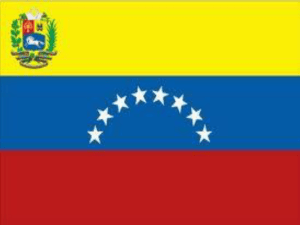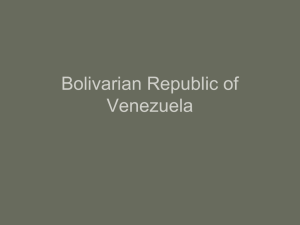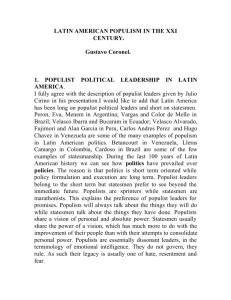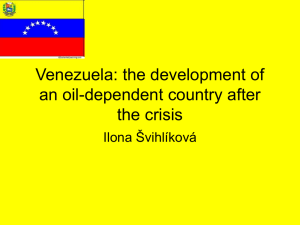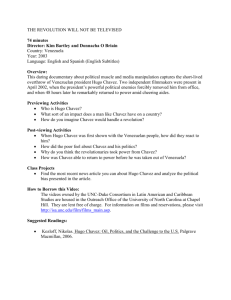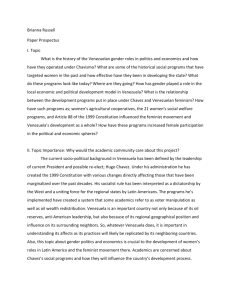Venezuela - Department of Computer Information Systems
advertisement
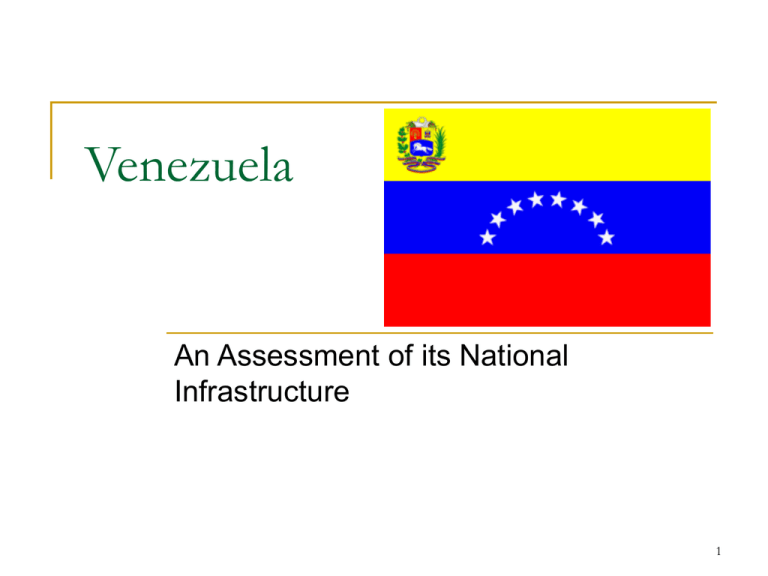
Venezuela An Assessment of its National Infrastructure 1 Map & Background Capital: Caracas Government: Federal Republic Chief of State: Hugo Chavez Frias Acts as both the chief of state and head of government National Assembly elected by people 2 Brief History Discovered by Columbus in 1498 Controlled by Spain from 16th century to early 19th century Independence from Spain in 1821 – Bolivarian Revolution Discovery of oil in early 20th century Oil boom in 1970s helped shape the economy Poor oil market of 1980s led to economic and political crisis. 3 Hugo Chavez: Madman or Savior? 4 Changing Flag & Crest 1954-2006 flag As of March 12, 2006 5 Rise of Populism in Latin/South America Moderate/Social Democratic Left Brazil – Luiz Inacio “Lula” da Silva Chile – Michelle Bachelet Costa Rica – Oscar Arias Uruguay – Tabare Vazquez Stand for prudent macroeconomic policies and retention of 1990s economic reforms Also, better social policies Latin American “traditional” Populism Venezuela – Hugo Chavez Argentina – Nestor Kirchner Bolivia – Evo Morales Possible leaders Peru – Ollanta Humala or Alan Garcia Mexico – Andres Manuel Lopez Obrador Nicaragua – Daniel Ortega (Sandinistas) ? 6 Chavez rise to power continues an uncertain political stability 2002 Coup to oust Chavez 2002-2003 general strike at PDVSA Oil makes up 1/3 of GDP 80% of all Venezuelan exports Over 50% of Government operating revenues Stability is mostly based on how well the oil market is doing. 7 Government promotion of IT Government promotion of IT very high Internet users increased 810% between 1998 and 2005 Opening of 2,000 public internet centers Pledging universal internet access of all citizens Projecting a 50%/year growth of internet usage. Currently, 4% of population access Internet a month. 8 Trade barriers to IT diffusion and IT ownership Free trade zone in Merida – Venezuela’s “Silicon Valley” Tax breaks and incentives to all national and international companies starting there. Telecommunications open to unlimited competition Includes fixed-line, cellular/mobile, cable, satellite, data and multimedia. Investments in infrastructure continue to rise. 9 Legal protections and copyright laws Improvement in copyright and IP law Piracy very rampant Andean Pact of 1994 Creation of National Copyright office in 1995 Protection of satellite signals nonexistent Especially true of US satellite signals Piracy rate up from 60% (1999) to 79% (2004) Intellectual Property protection still not adequate 10 Educational System Literacy rate (over age 15): 93.4% IT Literacy fairly low Especially away from the coast 32% of public schools have computer equipment Primarily used for administrative work Mostly obsolete No Internet access due to poor telephone service Very little teacher training Computer labs mostly found in universities 11 Language Official language is Spanish Also considered official “business” language Very little English spoken in countryside Upper class and businessmen speak English 12 Hofstede Analysis 12 Individualism 21 Power Distance 91 70 40 Uncertainty Avoidance 20 40 Latin America USA 73 48 0 Venezuela 76 80 46 Masculinity 81 62 60 80 100 13 IT Diffusion Phones per capita: 110 per 1000 people Computers per capita: 46 per 1000 people TVs per capita: 180-185 per 1000 people Extent of IT usage Mainly the oil and petrochemical industries Banking and finance sector Insurance Telecommunications Government and Customs Manufacturing and Industrial Sector 14 Telecommunications/Infrastructure Telecommunications Infrastructure is modern and expanding Still behind other South American counterparts However, digitalization of fixed lines growing 66.1% (1998) to 80.5% (2001) Privatization of industry leading to more growth. Only 5 out of every 100 people are internet users This number is probably higher, due to push for “public internet centers” No official standard for EDI Digital Access Index: 0.47 United States: 0.78 Brazil: 0.50 Colombia: 0.45 Peru: 0.44 15 Venezuela “Night Sky” Brightness Luminance map of Venezuela - 1997 16 Computer Industry Native hardware industry – very low Virtually no hardware manufacturing Some well-known hardware resellers have subsidiaries or operations in Venezuela Native software industry Growing, especially in the telecommunications, banking and petroleum sector. INTESA Joint venture between PDVSA and SAIC Largest information technology services company in Latin America PDVSA outsources IT services to INTESA, the largest in Latin America 17 Economy Physical Infrastructure best near cities Large number of airports Road quality decreases away from city centers. Privatization trends reversing Telecommunication and IT sector highly privatized Oil industry now state run PDVSA forced all foreign oil companies into joint ventures, or face a takeover 16 of 32 foreign companies so far have complied Total and Eni did not, fields were taken over by PDVSA 18 GDP Per Capita: $6,500 (2005 est) Growth rate: 9.1% (2005 est) Venezuela - GDP - real growth rate (%) 20.0% 10.0% 0.0% -10.0% -20.0% 16.8% 3.2% 2.7% -7.2% 1999 2000 9.1% 2001 -8.9% -9.2% 2002 2003 2004 2005 19 Joint Ventures & Stock Market Extent of Joint Ventures with International Firms Growing in technology sector All foreign oil companies are now forced into Joint Ventures Caracas Stock Exchange Emerging market Market cap of 7.59 billion 94 companies listed (1998) Only a few are telecommunications/IT companies Hard to get funding for companies Very expensive and inefficient Have to look to the United States or other developed countries. 20 Foreign Direct Investment Foreign Direct Investment growth slowing down However, still much better than pre-90s Companies still investing, especially in telecommunications Lucent launching 3G CDMA 2000 network end 2006 (2.4Mbps) Foreign Direct Investment (% of GDP) 4 3 2 1 0 -1 1970 1975 1980 1985 1990 1995 2000 2003 FDI -0.17 1.29 0.08 0.11 0.93 1.27 3.88 2.95 21 World Economic Forum’s Economic Creativity Index Attempts to measure country’s creativity and involvement in innovation Index based on observed data and survey results Measures the level of technology and the conditions favoring business start-ups. 22 Conclusion Future is uncertain Overall Assessment of IT Capability of Venezuela Economy too tied to petroleum sector Chavez government shaky Uncertainty in continuing privatization Emerging IT based economy with emphasis for growth Working hard with other regional countries to increase IT capability. Attractiveness of Venezuela from an IT perspective Seems to be attractive, albeit high risk. 23 Questions? 24
